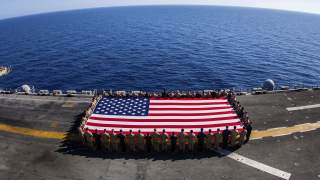Democracy Will Continue to Survive the World's Political Turmoil
While some view populism as a sign of rot, others argue that it reflects the strength of established democracies and their ability to weather criticism.
What Comes Next?
The administration can do much to exploit the three big advantages of established democracies and help our side win the world.
Step one: Refurbish the instruments of national power. If the United States is going lead in restructuring the global order, then it needs the means to exert global influence through robust hard power and soft power. That means a strong economy, a strong military and confident foreign policy.
Step two: Promote state-centric policies. From trade to security, U.S. policies should reflect America’s vision that established democracies ought to measure up to the tasks ahead. The administration has already started to do this. Witness, for example, its emphasis on the importance of burden sharing. The United States can’t be shy in making the case that revitalizing the concept of sovereignty is the salvation of—not the threat to—the free world. The United States also needs to get the established democracies working together to lead. In Asia, for example, Australia, Japan, India and America ought to be working together to engage China. The administration also needs to hold accountable the institutions, such as the UN, that support the international order. Rather than turn its back on international and multinational institutions, the United States should press them to do a better job supporting the established democracies.
Step three: Step up influencing friends and allies. The United States should put more effort into the sweet-spots, the “middling” states. China is always going to be China. On the other end, fixing basket-cases like Sudan is a heavy lift. States in the middle with a modicum of governance offer the United States an opportunity to fill out the ranks of the free. Washington should target strategically important states it can influence, adding better allies to America’s side.
Step four: Put the sidewalks where people walk. Rather than try to define what a future world order might look like, the United States should focus on the steps that will get it there. As free nations begin to dominate a world characterized by open-spheres of differing (hopefully not warring) interests, the need for the right kind of future institutions will emerge. These structures may be revitalized versions of current institutions; they may emerge from initiatives like the Council of Democracies, or they may be ideas not on the table yet. What they should be are structures that help sustain the freedom, prosperity and security that will be advanced by the association of established democracies.
A Heritage Foundation vice president, James Jay Carafano directs the think tank’s research on issues pertaining to national security and foreign affairs.
Image: U.S. Marines and Sailors assigned to the 26th Marine Expeditionary Unit (MEU), and Sailors assigned to the USS Kearsarge (LHD 3), hold the American flag to commemorate the Fourth of July during their 2013 deployment on the flight deck of the USS Kearsarge, at sea, July 4, 2013. DoD photo by Sgt. Christopher Q. Stone, U.S. Marine Corps/Released. U.S. Department of Defense Flickr
RECOMMENDED:
What a War Between NATO and Russia Would Look Like.
What a War Between America and China Would Look Like.
What a War Between China and Japan Would Look Like.

